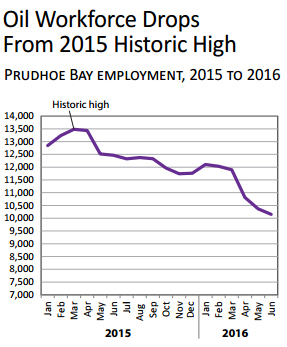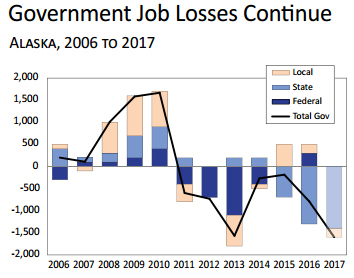
Thousands of Alaskans lost their jobs in 2016, and in the forecast for 2017, it doesn’t look like the economy is going to stop shrinking anytime soon.
Oil prices, the foundation of the state’s economy, have rebounded slightly but not enough to balance the state’s budget. A new state economic forecast predicted layoffs and job losses in nearly every sector of the economy.
State economists say cuts in the oil and gas industry, construction and the public sector have been so deep they’re causing job losses in nearly every other sector of the economy.
Alaska’s Department of Labor and Workforce Development economists say the state’s economy is in decline, and for the first time in decades, the state is going to have to fund the majority of its budget with something other than oil revenue.

That said, oil industry losses, the catalyst for the state’s rapidly shrinking economy, are expected to slow. According to the state’s employment forecast for 2017, the oil industry is expected to shed 1,400 jobs this year: about half of what it lost last year.
While oil prices are the main driver for the economy, state economist Caroline Schultz said they’re relatively easy to predict. The big unknown now is political.
“Legislative decisions and budget decisions made by the legislature and the governor, I mean, we don’t have as good of a read on how that’s going to pan out as we do on oil prices,” Schultz said.
Whatever the legislature decides to do this year probably won’t solve all of the state’s budget problems but could go a long way toward boosting consumer confidence and encouraging new business, Schultz wrote in her analysis.
Sectors of the economy like arts and entertainment and recreation will see big losses in 2017 as people spend less money. And, while a good tourist season will help with that loss, this year could be rough on restaurants and bars.
The financial services are also expected to take a hit as real estate and demand for financing slows.
Also, the public sector will be thinned again. At least 1,300 jobs were cut in 2016. Governor Bill Walker introduced a budget in mid-December that calls for another 400 state jobs to be cut by December of 2017.
There are some bright spots.

The healthcare industry is expected to keep adding jobs as the state’s population ages. In fact, it’s the only industry forecasted to grow, adding 500 new jobs this year.
Military spending is up with nearly $550 million in new hangars, buildings and construction contracts between Eielson and Fort Wainwright bases in Fairbanks.
In Anchorage and Southeast Alaska, the tourism industry could get a boost from large numbers of out-of-state travelers. Cruise ship bookings are up.
Schultz said there weren’t a lot of surprises when they were crunching the numbers for the 2017 forecast.
“We’re kind of past the hard part where we had to predict when the rough times were going to start,” Schultz said. “So now we can definitely in retrospect identify that they really started in 2016.”
Schultz said the new excitement is to predict when the state starts to come out of this slump. But that likely won’t happen in 2017.
Rashah McChesney is a photojournalist turned radio journalist who has been telling stories in Alaska since 2012. Before joining Alaska's Energy Desk , she worked at Kenai's Peninsula Clarion and the Juneau bureau of the Associated Press. She is a graduate of Iowa State University's Greenlee Journalism School and has worked in public television, newspapers and now radio, all in the quest to become the Swiss Army knife of storytellers.




